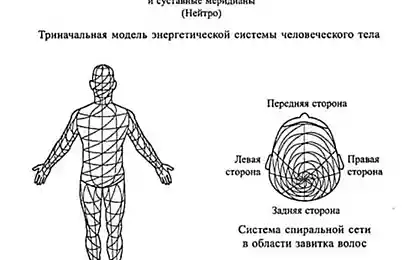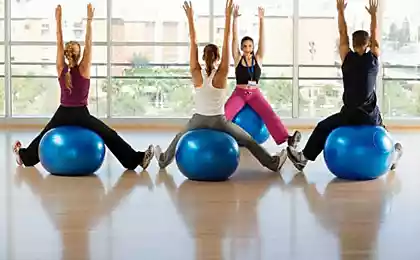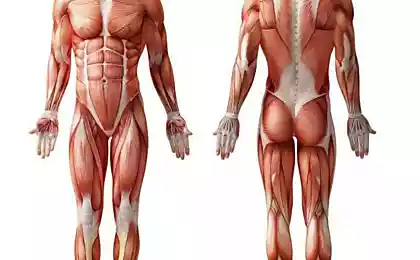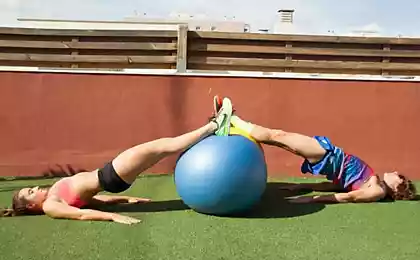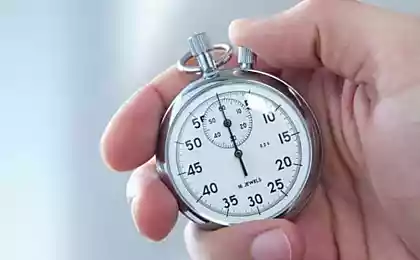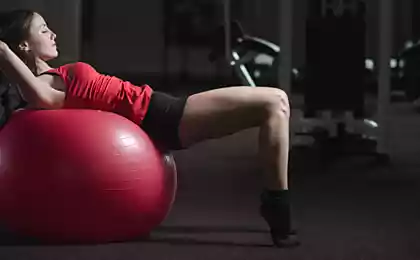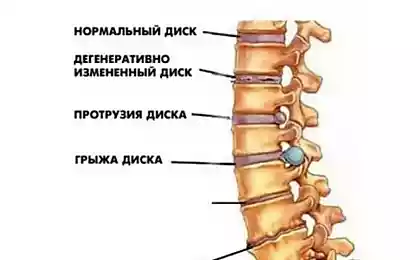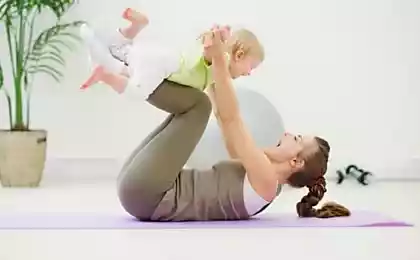555
Fitball exercises for spinal health.
Fitball exercises for beginners
The deficiency of motion, which arises in everyone who involved in the crazy rhythm of modern life requires compensation. Personal cars, sedentary work in offices and sedentary "couch" lifestyle are the causes of inactivity, poor posture and serious diseases of the spine.
Sixty four million six hundred ninety thousand five hundred forty two
To low back pain, vegeto-vascular diseases, diseases of the heart and muscular system were not between you and a happy healthy life, you need to push yourself in physical training.
There are many types of training using a variety of sports equipment. Among them arches for deflections, stepper, trampolines and exercise balls. Here on the fitball and we'll talk.
The fitball sport is a versatile projectile that can be used both at home and in the gym. Exercise balls are popular because they give excellent tone major muscle groups and isolated groups of muscles with maximum resistance. You can also use the fitball in conjunction with exercises for the upper body, lower back and oblique muscle groups.
The unstable situation makes the fitball unique. The instability of the ball forces you to develop the following skills needed to progress on the exercise program and maintain a healthy spine:
Joint mobility
Flexibility
Reaction time
Coordination
Posture
Balance
Strength
Proprioception
Next will be described the initial exercises with the fitball. They can be performed independently at home and in the gym with a trainer.
Elementary exercises with fitball:
Bridge
Eighty seven million seven hundred six thousand eight hundred forty nine
Ninety five million seven hundred eighteen thousand two hundred sixty nine
Original position:
Lying on your back, heels of feet on the fitball.
The arms are straight and located at the sides of your body.
Action:
Slowly lift hips until body part from the heels to the shoulders and will not occupy a level position.
Working groups of muscles:
Thighs, buttocks, hand and extensor muscles of the back.
Recommendations:
Beginner: 5 times within 10 seconds.
Average: 7 repetitions for 15 seconds.
Pros: 8 repetitions for 30 seconds.
Lifting the legs cross
Original position:
Lying on your back, heels of feet on the fitball.
Straight arms extended to the sides.
Raise your left leg toward the ceiling until, until you see your own heels on a.
Ninety four million seven hundred fifty eight thousand three hundred eighty seven
Action:
Slowly lower the raised leg to the side to the floor as you can. Ensure that the legs were straight.Do not let the hips SAG. Then again lift the leg up.Give it to the other side, as if to turn around the ball. Repeat this exercise for the other leg.
Working groups of muscles:
Oblique muscles of the abdomen, buttocks, thighs, back muscles.
Recommendations:
If you are performing this exercise positioning the palms to the top, it increase the load on the front muscles of the shoulders, arms and upper back.
If you are performing exercises to place the hands palms down, mostly will work the muscles of the shoulders and chest. Start to do this exercise slowly, until you feel your limit.
Frequency:
Beginner: 5 times for each leg.
Average: 10 times for each leg.
Pro: 15 times for each leg.
Clock
Original position:
To perform this exercises on a fitball, you need to lie back with knees bent at a 90 degree angle and place the heel of the feet on the fitball.
Hands apart on the floor.
It is necessary to lie close to the ball.
Twenty eight million one hundred two thousand nine hundred fifteen
Ninety four million six hundred nine thousand five hundred ninety one
Actions:
Turn both legs to one side along the fitball. I.e. we would ride the heels of the ball.
Move feet as much as possible, without lifting the shoulders off the floor.
Return to the starting position and repeat to the other side.
Working groups of muscles:
Oblique abdominal muscles, side muscles of the pelvis, hamstrings, buttocks, lower back.
Recommendations:
Keep tension in the abdominals throughout the exercise.
Make sure you can control the movement before you do the exercise for all possible amplitude.
If there is any discomfort, immediately stop.
Frequency:
Beginner: 5 reps for each side.
Average: 10 times for each side.
Pro: 15 times for each side.
Superman
Original position:
Lie with your abdomen on an exercise ball, chest lifted up. Hands to rest on the floor in front of him, keeping the balance, feet on the floor.
Thirty eight million four hundred eighty six thousand three hundred thirty four
Fifty eight million nine thousand seven hundred eighty seven
Actions:
Raise one arm along the body, at the same time raise the opposite leg. For example, raise the right arm and left leg.
Need to the raised parts formed together with the body straight horizontal line.
To stay in this position for 5 seconds.
Drop the arm and leg on the floor.
Repeat the exercise for the other side.
Working groups of muscles:
The muscles of the buttocks, thighs, back muscles, deltoids, rotator cuff.
Recommendations:
Don't forget to keep the neck straight, chest forward and chin up to avoid neck injury.
Keep elbows and knees straight.
If you think exercise is too hard, try to raise part of the body gradually.
Frequency:
Beginner: 6 times for each leg.
Average: 10 times for each leg.
Pro: 15 times for each leg.
Stop
Original position:
To perform this exercises on a fitball, you need to kneel in front of the ball with his back to him. Alternately lift your feet on a fitball, leaning on the floor hands. Ultimately, arms and legs should be straight and at right angles to each other, back straight, stomach sucked.
Ninety million two hundred eighty two thousand nine hundred twenty three
Actions:
To take the starting position and stay in it.
Working groups of muscles:
Sustainability is achieved through the work of the muscles of the back and pelvis.
Recommendations:
If the position is too heavy, try to change it, by placing an exercise ball under your knees, gradually moving it closer towards your toes.
Frequency:
Beginner to stay in the original position for 10 seconds.
Average: 20 seconds.
Pros: 40 seconds.
Push-UPS on my knees from fitball
Original position:
Kneel in front of the fitball and place your hands on the ball in front of him at shoulder width. Hands should be placed below the chest and above the pelvis.
Eighty million nine hundred ninety eight thousand one hundred sixty five
Actions:
Descend slowly on an exercise ball, resting his hands. Then slowly return the body to its original position.
Working groups of muscles:
Pectoral muscles, deltoids, triceps.
Recommendations:
Start slowly, don't forget to maintain a correct posture all the time of execution. Avoid sagging the hips forward.
If you find the exercise too difficult, try to find a suitable height for the support of the hands.
If you are experiencing pain in the shoulders or the shoulder blades – stop.
Frequency:
Beginner: 6 times.
Average: 10 times.
Pro: 15 times.
P. S. And remember, just changing your mind — together we change the world! ©
Source: i-stretching.ru/archives/1200
The deficiency of motion, which arises in everyone who involved in the crazy rhythm of modern life requires compensation. Personal cars, sedentary work in offices and sedentary "couch" lifestyle are the causes of inactivity, poor posture and serious diseases of the spine.
Sixty four million six hundred ninety thousand five hundred forty two
To low back pain, vegeto-vascular diseases, diseases of the heart and muscular system were not between you and a happy healthy life, you need to push yourself in physical training.
There are many types of training using a variety of sports equipment. Among them arches for deflections, stepper, trampolines and exercise balls. Here on the fitball and we'll talk.
The fitball sport is a versatile projectile that can be used both at home and in the gym. Exercise balls are popular because they give excellent tone major muscle groups and isolated groups of muscles with maximum resistance. You can also use the fitball in conjunction with exercises for the upper body, lower back and oblique muscle groups.
The unstable situation makes the fitball unique. The instability of the ball forces you to develop the following skills needed to progress on the exercise program and maintain a healthy spine:
Joint mobility
Flexibility
Reaction time
Coordination
Posture
Balance
Strength
Proprioception
Next will be described the initial exercises with the fitball. They can be performed independently at home and in the gym with a trainer.
Elementary exercises with fitball:
Bridge
Eighty seven million seven hundred six thousand eight hundred forty nine
Ninety five million seven hundred eighteen thousand two hundred sixty nine
Original position:
Lying on your back, heels of feet on the fitball.
The arms are straight and located at the sides of your body.
Action:
Slowly lift hips until body part from the heels to the shoulders and will not occupy a level position.
Working groups of muscles:
Thighs, buttocks, hand and extensor muscles of the back.
Recommendations:
- There are two points of stable contact and two points of unstable contact.
- As soon as you get tired your hips will start to SAG. Try not to allow it
- Do not lift the hips too high.
- Try to maintain a level position.
- Keep abdominal muscles tense.
Beginner: 5 times within 10 seconds.
Average: 7 repetitions for 15 seconds.
Pros: 8 repetitions for 30 seconds.
Lifting the legs cross
Original position:
Lying on your back, heels of feet on the fitball.
Straight arms extended to the sides.
Raise your left leg toward the ceiling until, until you see your own heels on a.
Ninety four million seven hundred fifty eight thousand three hundred eighty seven
Action:
Slowly lower the raised leg to the side to the floor as you can. Ensure that the legs were straight.Do not let the hips SAG. Then again lift the leg up.Give it to the other side, as if to turn around the ball. Repeat this exercise for the other leg.
Working groups of muscles:
Oblique muscles of the abdomen, buttocks, thighs, back muscles.
Recommendations:
If you are performing this exercise positioning the palms to the top, it increase the load on the front muscles of the shoulders, arms and upper back.
If you are performing exercises to place the hands palms down, mostly will work the muscles of the shoulders and chest. Start to do this exercise slowly, until you feel your limit.
Frequency:
Beginner: 5 times for each leg.
Average: 10 times for each leg.
Pro: 15 times for each leg.
Clock
Original position:
To perform this exercises on a fitball, you need to lie back with knees bent at a 90 degree angle and place the heel of the feet on the fitball.
Hands apart on the floor.
It is necessary to lie close to the ball.
Twenty eight million one hundred two thousand nine hundred fifteen
Ninety four million six hundred nine thousand five hundred ninety one
Actions:
Turn both legs to one side along the fitball. I.e. we would ride the heels of the ball.
Move feet as much as possible, without lifting the shoulders off the floor.
Return to the starting position and repeat to the other side.
Working groups of muscles:
Oblique abdominal muscles, side muscles of the pelvis, hamstrings, buttocks, lower back.
Recommendations:
Keep tension in the abdominals throughout the exercise.
Make sure you can control the movement before you do the exercise for all possible amplitude.
If there is any discomfort, immediately stop.
Frequency:
Beginner: 5 reps for each side.
Average: 10 times for each side.
Pro: 15 times for each side.
Superman
Original position:
Lie with your abdomen on an exercise ball, chest lifted up. Hands to rest on the floor in front of him, keeping the balance, feet on the floor.
Thirty eight million four hundred eighty six thousand three hundred thirty four
Fifty eight million nine thousand seven hundred eighty seven
Actions:
Raise one arm along the body, at the same time raise the opposite leg. For example, raise the right arm and left leg.
Need to the raised parts formed together with the body straight horizontal line.
To stay in this position for 5 seconds.
Drop the arm and leg on the floor.
Repeat the exercise for the other side.
Working groups of muscles:
The muscles of the buttocks, thighs, back muscles, deltoids, rotator cuff.
Recommendations:
Don't forget to keep the neck straight, chest forward and chin up to avoid neck injury.
Keep elbows and knees straight.
If you think exercise is too hard, try to raise part of the body gradually.
Frequency:
Beginner: 6 times for each leg.
Average: 10 times for each leg.
Pro: 15 times for each leg.
Stop
Original position:
To perform this exercises on a fitball, you need to kneel in front of the ball with his back to him. Alternately lift your feet on a fitball, leaning on the floor hands. Ultimately, arms and legs should be straight and at right angles to each other, back straight, stomach sucked.
Ninety million two hundred eighty two thousand nine hundred twenty three
Actions:
To take the starting position and stay in it.
Working groups of muscles:
Sustainability is achieved through the work of the muscles of the back and pelvis.
Recommendations:
If the position is too heavy, try to change it, by placing an exercise ball under your knees, gradually moving it closer towards your toes.
Frequency:
Beginner to stay in the original position for 10 seconds.
Average: 20 seconds.
Pros: 40 seconds.
Push-UPS on my knees from fitball
Original position:
Kneel in front of the fitball and place your hands on the ball in front of him at shoulder width. Hands should be placed below the chest and above the pelvis.
Eighty million nine hundred ninety eight thousand one hundred sixty five
Actions:
Descend slowly on an exercise ball, resting his hands. Then slowly return the body to its original position.
Working groups of muscles:
Pectoral muscles, deltoids, triceps.
Recommendations:
Start slowly, don't forget to maintain a correct posture all the time of execution. Avoid sagging the hips forward.
If you find the exercise too difficult, try to find a suitable height for the support of the hands.
If you are experiencing pain in the shoulders or the shoulder blades – stop.
Frequency:
Beginner: 6 times.
Average: 10 times.
Pro: 15 times.
P. S. And remember, just changing your mind — together we change the world! ©
Source: i-stretching.ru/archives/1200

